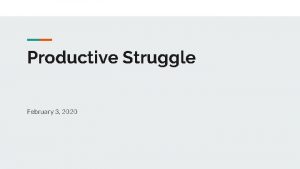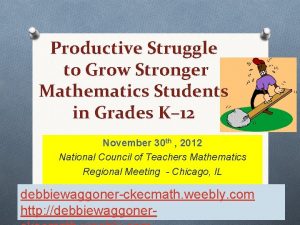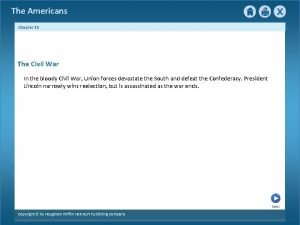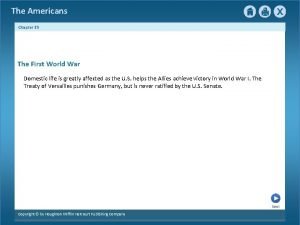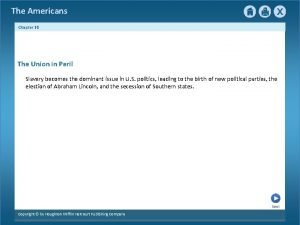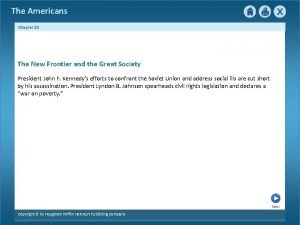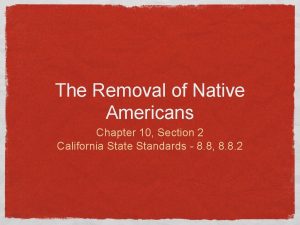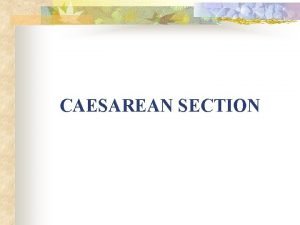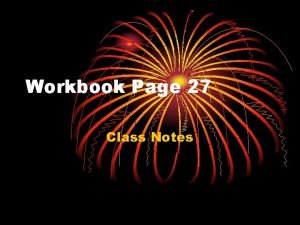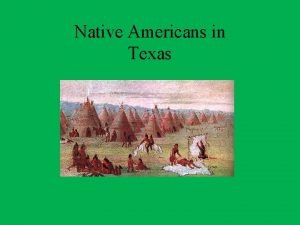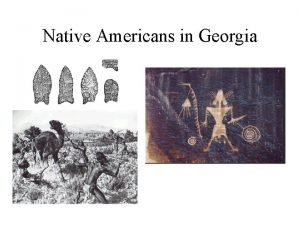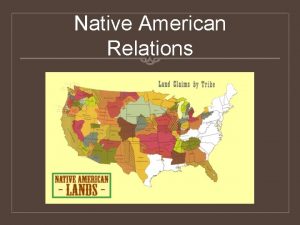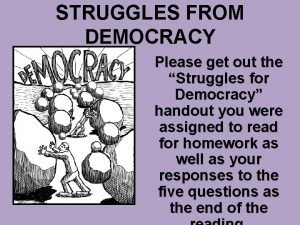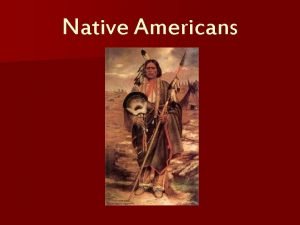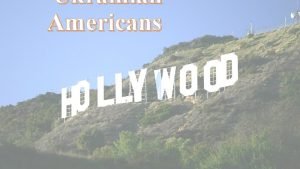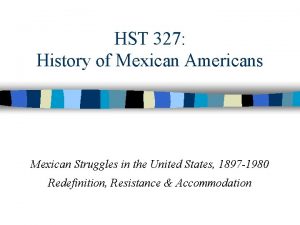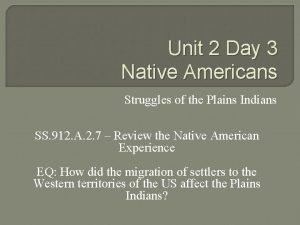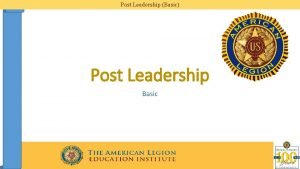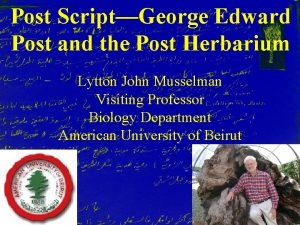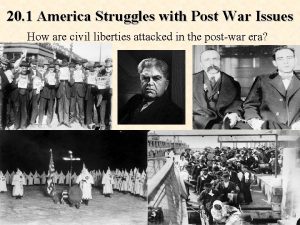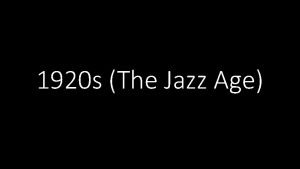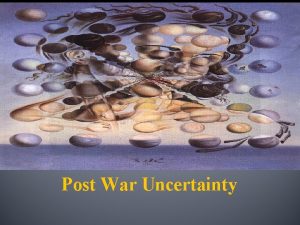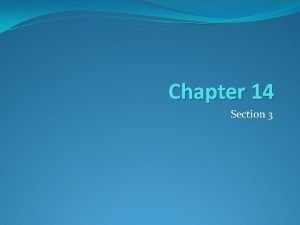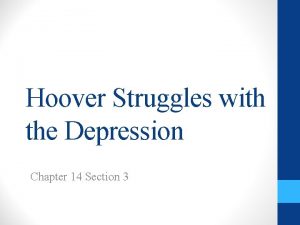Chapter 12 Section 1 Americans Struggles with Post

















- Slides: 17

Chapter 12 -Section 1 Americans Struggles with Post War Issues

Post War Trends • America is tired after WWI • Lots of adjustment had to take place: • Soldiers are trying to adjust to life without war why the economy tried to adjust to European countries not needing our

Post War Trends • Nativism-A prejudice against foreign-born people • Isolationism-The policy of pulling away from involvement in world affairs

Communism • Communism-An economic and political system where everything is controlled by the government and there is no private property or private ownership of business – Government would control things like factories, railroads, large scale farms and businesses • Red Scare-Many Americans were afraid Communism would take over the country following the overthrow of the Russian czar in 1919. • Soon after a Communist party in America formed with roughly 70, 000 members – They mailed bombs Attorney General Palmer starts to combat the “Red Scare” by using extremely harsh tactics

The Palmer Raids • In August of 1919, A. Mitchell Palmer and Herbert Hoover begin to hunt down suspected Communists, socialists and anarchists in the United States. • The fear of outsiders and communists got so bad that people who were different were singled out • Mitchell and Hoover trampled over peoples civil rights by searching their homes, mail, tapping their phones and even deporting people. • After all their searching they never really found evidence of a revolutionary conspiracy

Sacco and Vanzetti • Nicola Sacco and Bartolomeo Vanzetti were two immigrant anarchists who were accused of murder without much proof in 1920 • After a weak trial they were both sentenced to death by electric chair • People all around the world protested especially since they may have been innocent


Limiting of Immigration • Many people wanted to Keep America for Americans • New Anti-immigrant groups popped up because they thought immigrants were stealing jobs • The Ku Klux Klan resurfaces • 1920’s saw rise of KKK which began to diversify their hatred eventually reaching nearly 4. 5 million followers in 1924


Legal Measures to Limit Immigration • The Quota System-From 1919 to 1921 the number of immigrants entering had grown by 600 percent from 141, 000 to 805, 000 • Emergency Quota Act 1921: – It set a maximum number of people from each foreign country • Quota Act of 1924: – Limited immigration even more especially those from southern European countries to 2% of the nationals living in the U. S. • Quota Act of 1927: – Limited even more and included Japanese to only

Labor Unrest • Another problem facing the early 1920’s • After war strikes were rampant • Owners said strikers were communist • This was an attempt to try and scare people from joining unions



Labor Unrest • Boston Police Strike: • Boston police had not received a raise since before WWI and were not allowed to for a union so in 1919 they went and strike • Massachusetts Governor Calvin Coolidge fired the police and called out the national guard to remove them • The strike ended but new officers were hired instead of calling the old ones back • This proved that the government had power over labor

Labor Unrest • Steel Mill Strike • Steel workers wanted lower hours and a living wage • In September 1919, over 300, 000 workers at U. S. Steel Corporation went on strike • Strikers were beaten by police, federal troops and state militias. • The workers labeled as communist • The strike finally ended in 1920 and although the workers won an eight

Labor Unrest • Coal Miners Strike • Unions had some success in coal mines • John L. Lewis a labor leader led the strike of the United Mine Workers of America • He told the owners it was over, but kept it going • President Wilson brought end to it by bringing in an arbitrator. • Coal workers received a 27%

Labor Loses Appeal • Labor movements begin to lose support during 1920’s • Union membership dropped from 5 million members to around 3. 5 million • There were too many immigrants who were eager to work • The fact that immigrants spoke different languages made it hard to organize unions • Farmers who had moved to the cities were not used to working together • Most unions excluded African
 Chapter 14 section 3 hoover struggles with the depression
Chapter 14 section 3 hoover struggles with the depression Define productive struggles
Define productive struggles Benefits of productive struggle
Benefits of productive struggle Struggles or problems between opposing forces.
Struggles or problems between opposing forces. Chapter 11 section 5 the legacy of the war
Chapter 11 section 5 the legacy of the war Chapter 19 section 4 wilson fights for peace
Chapter 19 section 4 wilson fights for peace The americans chapter 18
The americans chapter 18 Chapter 15 immigrants and urbanization
Chapter 15 immigrants and urbanization The americans chapter 10
The americans chapter 10 The americans chapter 28
The americans chapter 28 The americans chapter 10
The americans chapter 10 Chapter 10 section 1 meiosis
Chapter 10 section 1 meiosis Doyen retractor contraindications
Doyen retractor contraindications What did americans underestimate in their eagerness for war
What did americans underestimate in their eagerness for war Coahuiltecan tattoos
Coahuiltecan tattoos Where did native americans come from
Where did native americans come from How many native americans died on the trail of tears
How many native americans died on the trail of tears British and american word differences
British and american word differences

